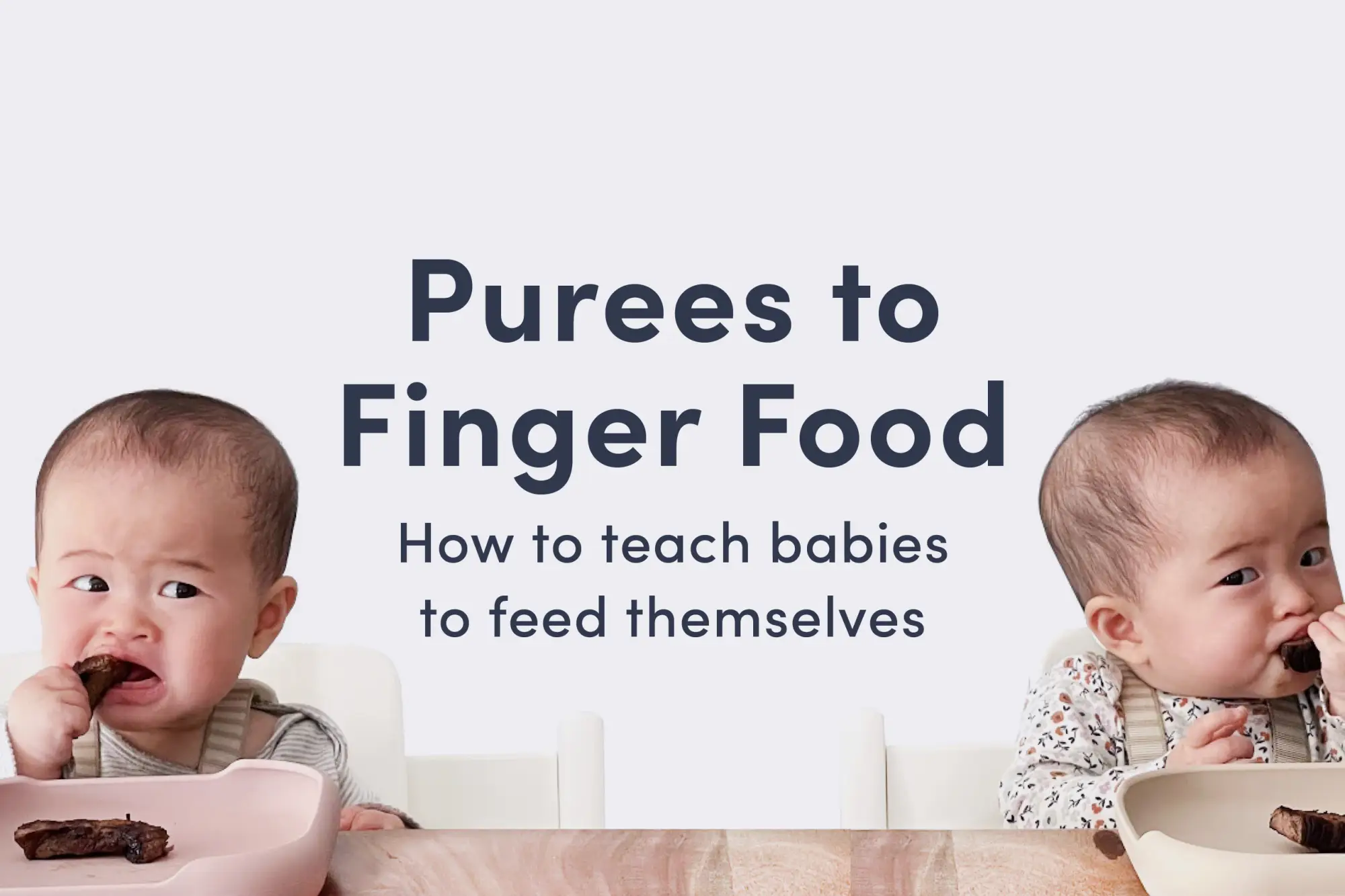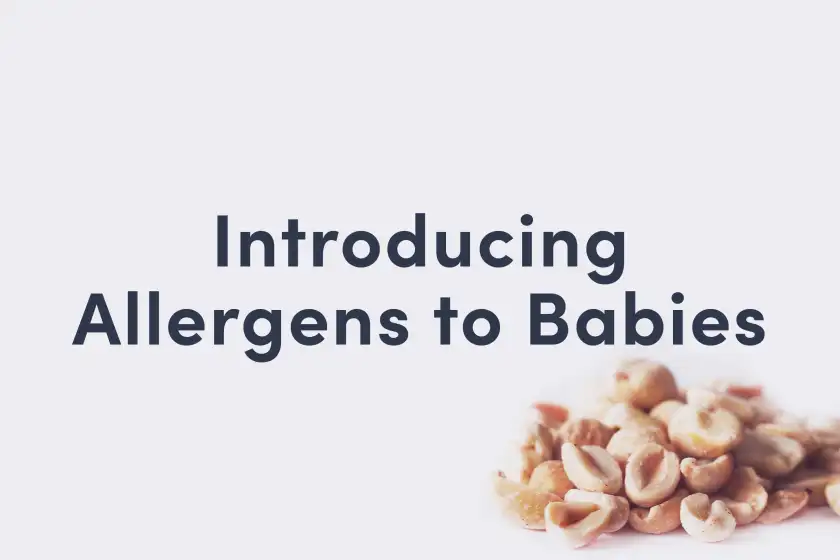Transitioning from Spoon Feeding to Finger Food

It’s not uncommon to face challenges when transitioning baby from spoon-fed purées to finger foods. Babies transitioning to finger foods are working hard at developing lots of new skills, such as chewing and moving food around to swallow, mapping the mouth, and learning where and how food moves in the mouth. Common challenges include refusing to touch food or self-feed, frustration, and gagging.
If you are struggling with the transition from purees to finger food, or spoon-feeding to self-feeding, check out Purees to Finger Food.
How do I get baby to feed themselves?
Most babies, when given the opportunity, will instinctively bring food—and other objects—to their mouths without any prompting from a caregiver. However, if a baby has been exclusively spoon-fed for a period of time, baby may stop trying to grab the utensil or food and rely on the caregiver to place it in their mouth. While this is okay in the beginning, it can make for a tricky transition to self-feeding.
If you have offered finger food and baby is not engaging with it or is playing with it but not bringing it to their mouth, consider seeking some extra support in making the transition to self-feeding. Our recorded webinar, Purees to Finger Food, covers all of the strategies to jumpstart self-feeding and will help you make the transition as smooth and battle-free as possible.
When will babies use their own spoon independently?
It takes time. Most toddlers will develop the fine motor skills to scoop and steadily bring their own spoon to their mouth consistently around 15 to 24 months of age, depending on how long they have been practicing.
While it can be frustrating to wait and watch, trust that it will come in time.
Offer foods that cling to the spoon easily such as thick oatmeal, mashed potatoes, mashed avocado, egg salad, polenta, mashed vegetables, and thicker yogurts like Greek yogurt.
Show the child how to load the spoon and then let them try.
Note that even when toddlers establish the skill to use their utensils by themselves, many children will go back and forth between the utensil and their fingers. This is developmentally appropriate and may continue for a couple of years. Many toddlers tire of using the skills to use utensils all the time and know it’s faster and more efficient to use their fingers. Try not to micromanage how your child eats, and instead focus on establishing a positive relationship with food and family mealtimes. Manners will come later with consistent modeling.
When is it safe to introduce finger food to babies?
It’s safe to introduce finger foods as soon as baby is developmentally ready for solids.
While generations in the 1900’s often started solids with commercial baby food purées, there’s no developmental need or evidence for starting solids with purées. In fact, research shows that there’s an optimal window for introducing chewable food between 6 and 9 months of age. Around 6-9 months old, babies have a set of reflexes and oral motor mechanisms in place to support chewing and learning to eat solids. Triggering these reflexes through exploration of finger foods helps baby build tolerance to chewable foods and encourages practice of new skills, which leads to the ability to eat a wide variety of food sizes, shapes, and textures by 12-18 months old.
Research shows that waiting to introduce textured solids and chewable finger foods until after 9 months, and especially after 12 months, increases the likelihood of refusal, increases risk of picky eating, and makes it more challenging for the infant to learn these critical oral motor skills.
As long as the food is modified to be safe for baby to eat, you can introduce “real” food as soon as baby is ready to start solids, which for many babies is around 6 months of age. To learn more about how to introduce real food to babies, use our First Foods® database where you can see how to prepare and cut any food to make it age appropriate for your baby.
What are the best first finger foods for babies?
In general, when transitioning from purées to finger food, focus on foods that are densely nutritious, easy for the child to pick up and hold independently, and safe for your child’s age.
Look up how to prepare any food for your child’s specific age with our First Foods® database or app.
Is it too late to do baby-led weaning?
Never. It’s never too late to learn a new skill.
While baby-led weaning is technically a mode of starting solids with finger food, many people now use baby-led weaning interchangeably with starting finger food or chewable food.
To learn how to safely transition from purées to finger food, watch our recorded webinar, Purees to Finger Food, which covers all of the strategies to jump start self-feeding.
If you are just starting solids and would like to jump right to finger food with baby-led weaning, use our First Foods® database or app or watch our course on starting solids with real food.
See our guides on starting solids for more information on which foods are best to start with, recipes, how-to manuals, and more.
How do I know if baby is getting enough to eat?
Generally speaking, babies are getting enough to eat when:
They are able to sustain consistent periods of being content, alert, and playful.
Peeing several times a day.
Pooping daily or every few days.
Energetically exploring their environment.
Learning new skills.
Steadily growing.
Up until 12 months of age, the primary source of nutrition should be breast/human milk or formula and complemented by nutrient-dense solid food beginning around 6 months old. This means that even if baby eats no solids at multiple meals, they can still receive adequate nutrition from nursing or bottle feeds.
During this phase, remember that learning to eat solid foods takes time and babies will often swallow very little solids at some or many meals. Babies will continue to consume about the same volume of breast/human milk or formula as they did prior to starting solids. If you are offering baby solid food two to three times a day (or three meals and two snacks after 12 months old) and continuing to offer breast/human milk or formula feeds until around 12 to 15 months old, baby should be getting enough to eat.
If you have any concerns about baby’s weight or growth, check in with the child’s health care provider.
Ready to get started?
Download the app to start your journey.
Expert Tips Delivered to Your Inbox
Sign up for weekly tips, recipes and more!






